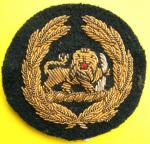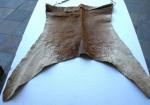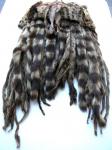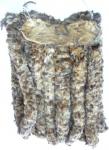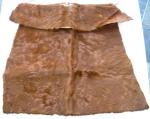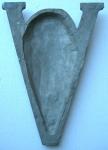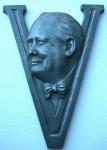-
Posts
13,225 -
Joined
-
Last visited
-
Days Won
22
Content Type
Profiles
Forums
Blogs
Gallery
Events
Store
Everything posted by Mervyn Mitton
-
I have always taken this bayonet to be the Carcano - Italian and basically the Infantry pattern. The Portuguese also used a similar bayonet , with brass trimming on the scabbard. Having looked again at the Crown, I am now a little undecided as to whether it is Italian or, Portuguese. I will post a few pictures and will be interested in comments - Joe, what do you think ? Stamped in the leather is - ACI 1910 or, 19010. So, it could be a date or, an armoury number.
-
An interesting badge for a senior officer of the Rhodesian Army - during the UDI period - which of course came to an end in 1980. This cap badge was for a Brigadier and was the rarest of three patterns. PERHAPS OTHER MEMBERS CAN ADD THE OTHER BADGES OF THE ARMY WORN AT THAT TIME
-

Zulu items
Mervyn Mitton replied to helen's topic in Great Britain: Militaria: Badges, Uniforms & Equipment
-

Zulu items
Mervyn Mitton replied to helen's topic in Great Britain: Militaria: Badges, Uniforms & Equipment
-

Zulu items
Mervyn Mitton replied to helen's topic in Great Britain: Militaria: Badges, Uniforms & Equipment
-

Zulu items
Mervyn Mitton replied to helen's topic in Great Britain: Militaria: Badges, Uniforms & Equipment
A different style of Nene - and probably for a more senior chief. The trim at the top is Civet cat - being spotted it was reserved for chiefs. The long strips are for a Genet. Although this animal - about the size of a small fox, looks like a cat - it is in fact the largest member of the Mongoose family. Very destructive to other smaller animals and birds. -

Zulu items
Mervyn Mitton replied to helen's topic in Great Britain: Militaria: Badges, Uniforms & Equipment
-

Zulu items
Mervyn Mitton replied to helen's topic in Great Britain: Militaria: Badges, Uniforms & Equipment
-

Zulu items
Mervyn Mitton replied to helen's topic in Great Britain: Militaria: Badges, Uniforms & Equipment
I'm assuming that there is a continuing interest in this historical Zulu equipment ? I am showing to day, examples of the everyday dress for a Zulu warrior of the 1870's period. They only wore skins - not having invented weaving - one of the reasons that today you often see a variation of the Nigerian gowns being worn. Although for Zulu ceremonies the King and his prime minister, will wear leopard skins. Basically, the problem was to cover the private parts and the rear. For the front many items could be used - grass, skins,tails, - anything that would flex with the body and drape over 'things' when they sat or, squatted. This item of dress is called a NENE. For the rear it was much simpler - a skin - usually a calf, or, sometimes a goat - would be tied around the waist - calf was preferred , being more supple. This is called a BESHU. The skins used often denoted the rank of the wearer - any spotted cat was reserved for Indunas or, chiefs. Leopards are for Royalty and Lion for the King. These major skins are draped or, hung from the shoulders. A Zulu always carries either his spear (now 'frowned' on) or a stick - provisions are made for these as 'traditional weapons'. This first Nene is made-up of twelve wild cat tails. These are not household cats gone wild, but the real wild cats. Very ferocious, they are becoming rare - one of the major problems with so many people wanting to wear skins. The two examples I am showing are for older, senior people - so, they are larger andcover more. The young warriors used to cut back the Nene until it barely covered anything and in battle would shake their 'personal equipment' at the enemy - all part of the posturing to intimidate your enemy. We used to wear high hats and striped trousers to look taller. -
Hi - Thomas. 'Teach' - indeed!!! I'll get my cousin - the Dr. , she lives in Capetown, to 'call' on you... Despite the problems of a hemet , and Leigh pointed some out - even he agreed that he liked it. Because of the height it can be seen in a crowd - there is always a collective sigh of relief when it is spotted coming through the masses of useless on-lookers.
-
This hat is the pattern for the Commissioner and the Deputy Commissioner of the Metropolitan Police (London). QE2 crown. Note the double row of silver braid oak leaves on the peak. The Commissioner is Britain's most senior police officer. He is followed by Her Majesty's Inspector of Constabulary - and third , is the Dep. Comm. Chief Constables rank alonside Met. Asst. Comms.
-
Brett - your comments are so true regarding the vandalism. Some of it could just be prejudice - i.e. Afrikaans , British, or, Zulu children listening to parents and then doing damage - but when you bring bull dozers to a cemetary to see what you can find !! The famous story - and I mention no names, or, clues to identity, - was the overseas dealer who provided the night guard at Isandlawana with a metal detector and told him where to dig. I believe in this case there was a prosecution - however, the last time I visited Isandlawana , guess who was on the gate ???
-
Stuart - I have said it before - I think this is one of the finer collections and all in such wonderful condition. My favourite has to be the bell Top Shako, but, closely followed by the Gentleman at Arms. Peter is hoping to become a museum curator - doesn't bode well for the museum when you can't spot a billiard table !!! (Sorry , Peter !)
-
Robin - GREAT ! Now we need someone to 'lift' my right arm in my photo to salute you.... Interesting that your Force had your cap with silver braid for a Chief Inspector. The Met. don't get that until Superintendent. Mervyn Would be nice if other Police members would post their uniform photos - not only UK, but all Countries.
-
Mike - you did no such thing - we all post in the hope that someone will find it of interest - and not say to themselves 'it's him again' !!! I have several tapes of old Troopings, but today, most people don't have the machine to play them - all DVD's. I was actually quite 'shocked' that Thomas had never seen the ceremony - however, he is young (ish !) and they don't show things like this on S.A. TV. So, it was good that you found ref. How many others won't know, but will keep quiet ?? Mervyn
-
Thomas - so pleased I can 'intimidate' someone ! The 'Trooping of the Colour' is one of the highest ceremonial days in Great Britain - I suppose it ranks with the Cenotaph commemorative. The Saturday nearest to June 12 th. is always used for TtC - that being the date for H.M. The Queen's 'official' birthday. The real date is a family affair. The Guards Regiment scheduled for that year - Troops it's Colours in front of The Queen. It will be augmented by 6 or 7 Companies from other Guards Regiments and used to be of 8 Company strength- thinking about it, I believe this has been reduced to 6. The combined bands of all the Guards Regiments are present and , in addition the Life Guards and The Blues and Royals parade with their bands. Finally, in recent years - King's Troop of Royal Horse Artillery also parade their guns. My old Division (H) used to be in front of the Guards Memorial and as we faced front in those days , had the best view of all. It was about the only thing I volunteered for. See if you can buy a DVD - it is a wonderful event.
-
A little 'faded' with age - like me - this was taken on the day of the 1969 Trooping of the Colour. All my friends decided we wanted a photo in our number one uniform and met in a local park , before going on the police coach to Horseguards. This uniform is virtually the same as amended in the 1870's and was made of wonderful Melton Cloth , with buttons all down the bottom of the back of the tunic. Note we had no epaulettes and our numbers were on either side of the collar. A year, or two, later they withdrew them and sold them off to Elstree Film Studios for ?3.50 each ($5) each ! Only 5000 men in the inner divisions wore them - and we always wore white gloves.
-
Going through an old photo album the other day, I found these two pictures from my Metropolitan Police days. This was taken at Hendon Training School and as I was a Probationer Constable, I am not wearing a whistle. We had an enormous fall of snow and all took turns having our photos taken. December 1967 - I was 30 !! After Leigh's comments about changes in uniform - this is what a policeman used to look like....
-

BRASILIAN BADGES
Mervyn Mitton replied to Mervyn Mitton's topic in Rest of the World: Militaria & History
Douglas - thankyou. I will look it up - I don't collect these badges, must say they are well made and attractive. Mervyn -
Cast from aluminium during WW2 this rare item shows Sir Winston Churchill in the centre of his famous war victory sign 'V'. The probability is that it was cast from either a 'downed' British or, German aircraft - this was quite common and the castings were then sold for the War Effort. The back is un-polished and has no markings. During the War my family owned five acres (2.5 hectares) of green (glass or, hot) houses in Greenwich - near the naval College - we had the job of growing tomatoes for London , since the Channel Islands were occupied. Churchill's driver would come regularly for tomatoes for 10 Downing Street - the car was a big Humber - the type with the squared back (so a top hat could be worn) - the back window was so scarred and scratched you couldn't see in or, out. The chauffer said it was Society women trying to get to Churchill and that it was their diamond rings that had caused the scratches !!!



